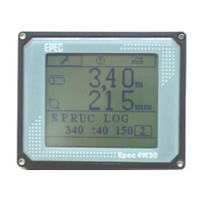PRESELECTIONS
The preselections are pre-programmed data of the different types of
pieces to be produced. The preselections consist of 5 different data:
Tree species, Wood type, Length, Tolerance and Top diameter
minimum.
Tree species is the botanical name of the tree (i.e. fir, pine).
Wood type defines the use of the piece, for instance: if the pieces are
intended for manufacture of paper, the wood type can be PULP, and if
the pieces will be sawed to boards, the wood type can be LOG.
Length is the desired length of the pieces to be made.
Tolerance is the accepted deviation from the desired length.
Top diameter is the minimum acceptable top diameter (given in
millimetres).
When pressing the preselection after the sawing, the harvester starts to
feed the tree to the length of the preselection in question, observing the
crosscutting tolerance and the desired top minimum diameter of the
piece. If the diameter falls below the top minimum, the feed is
interrupted at the diameter limit.
The sawed piece is counted into the statistics of the preselection used.
The number of running meters and the number of pieces produced for
each preselection are added up. If diameter is used, the volumes are
calculated, and if trunk counter is used, the trunk numbers are counted
too (the trunk numbers are added always into that preselection, to which
the first piece of the trunk is made).
CONTROL KEYS OF THE GRAPPLE
The control keys of the grapple are used to control the grapple
functions. In order to ensure easy working, these keys are located either
in the crane levers or very close to them. More detailed information is
given in section "4. Grapple functions".
Tree
species
Length Tolerance
Wood type
Top minimum
Active preselection

